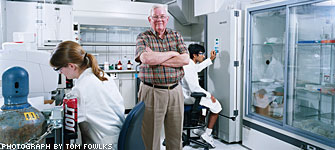But enough about me, let's talk about me. As we established in Week One: NanoBot Held Hostage (until Howard gets a job), I am a well-respected man among those who have worked with me, followed my work or have used my tummy as a trampoline. But, you may ask, "Is that all there is to you, Howard? There are a great many other competent editors out there looking for work. To say you're a dime a dozen would be an insult to the dime. What else can you do?"
And, to that I would answer, "Mom, please try to say positive things about me in public, but you do have a very good point."
What my resume might not reflect (and, come to think of it, I should probably add
this to the document) is my research work these past two years since leaving
Small Times. In addition to providing countless backgrounders for members of
the media looking for information about nanotechnology in general or about
the companies I've done contract work for, I also:
Researched and co-wrote a lengthy report on nanotech-enabled memory and
storage for the market research firm NanoMarkets. Also for
NanoMarkets: I edited and rewrote a research paper on batteries and fuel cells;
Researched and co-wrote a report commissioned by the U.S. Army tank
command here in the Detroit area, evaluating MEMS and nanotech companies for
possible partnerships in unarmed land vehicles;
Researched companies and labs working on ophthalmic drug delivery
technologies for a major pharmaceutical firm.
Evaluated an author's proposal for Artech House, publisher of books for
high-tech professionals. Then, about a year later, critiqued and
fact-checked the author's final manuscript.
There's more, but I do take the phrase "nondisclosure agreement" very seriously and will certainly not blog them. And, as you might know, a large part of the job for a magazine assigning
editor -- especially one covering a technology that had never before been
covered as a business -- is conducting research during the assigning,
rewriting and editing process. So, during the five years that I've devoted to covering this little nano corner of the world, I've done a great deal of behind-the-scenes work that you will not necessarily see in my clips, but that has resulted in better final products.
Despite my loudmouthed, opinionated, egotistical, nutty-for-nanobots blog persona, I am also quite comfortable quietly sifting through background material on the nanotech of "here and now" and using my insights and experience to help spot trends. Those of you who read a great deal of literature about nanotech as a science, business and investment have probably read my work and not even known it.

Oh, and my son Sam tells me that I should have "researched" the weather a little better before making him sit in the stroller in the rain during the recent
"Fly-In" at Woolsey Memorial Airport in Northport, Mich. As you can see, to use a cliche in community journalism, the rain did indeed
"dampen the enthusiasm" of at least one spectator watching a helicopter take off.








